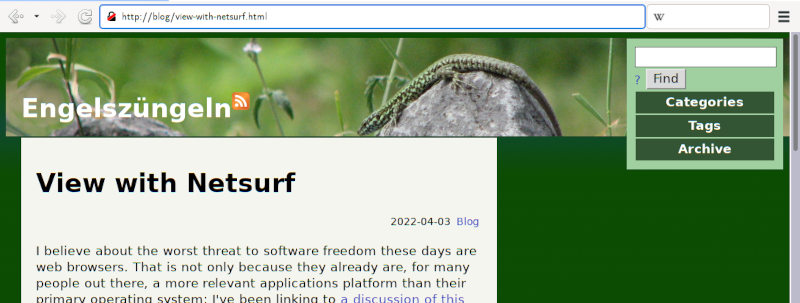
An early version of this post rendered in netsurf.
I believe about the worst threat to software freedom these days is web browsers. That is not only because they already are, for many people out there, a more relevant applications platform than their primary operating system, and that almost everything that gets run in them is extremely non-Free software. I've been linking to a discussion of this problem from these pages since this blog's day one as part of my quip on “best viewed with javascript disabled“.
No, they are also a threat because the “major” browser engines are so humunguous that they are in effect locking out most platforms (which simply don't have enough power to run them). And they are because the sheer size and complexity of their code bases make it essentially impossible for an individual to fix almost any relevant bug in them related to rendering, javascript execution, or network interactions.
That is why I am so grateful to the authors and maintainers of both dillo (Debian: dillo) and netsurf (Debian: netsurf-gtk, mainly), small browsers with maintainable code bases. While dillo is really basic and is missing so much of CSS and modern HTML that on today's web even many non-adversarial sites become barely usable, netsurf is usually just fine for websites respecting user rights.
Flex layouts and the article elements: The good part of 20 years of web development after the Web 1.0.
I have to admit I nevertheless only use it in very specific contexts, mostly because luakit with its vi-like key bindings and lua extensiblity in the end usually wins out even though I don't trust the webkit rendering engine for two cents[1]. And that is why I hadn't noticed that this blog has rendered a lot worse than it should have in netsurf. This is particularly shameful because that was mostly because I have taken liberties with web standards that I should not have taken. Apologies: Netsurf was right and I was wrong.
I have improved that quite a bit this morning. Given I am using flex layouts quite liberally here, and these don't work in Debian stable's netsurf, the rendered pages do look quite a bit different in netsurf than on the “major” browsers. But the fallbacks are ok as far as I am concerned. Since flex layouts are among the few “innovations“ in the post-Web 1.0 ecosystem that are actually a good idea, I gladly accept these fallbacks. Let me stress again that it is a feature of a friendly web rather than a bug that pages look different in different user agents.
Dillo, regrettably, is another matter because of the stupid^Wunderconsidered colour games I'm playing here. As things are right now, the light background below text like this one sits on an HTML5 article element, which dillo ignores. Hence, the text is black on dark green, which, well, may be barely readable but really is deeply sub-optimal. Since I consider the article element and its brethren real progress in terms of markup (the other positive “innovation” post Web-1.0), I will not change that markup just to make this render better in dillo. I may finally re-think the silly dark green background soon-ish, though.
| [1] | If you feel like this, too, let's team up and massage luakit's front end to work with netsurf's rendering engine. Given the close entanglement of luakit with the webkitgtk API, this certainly will result in a very different program, and almost certainly there would be no way to re-use luakit extensions. Still, I could very well see such a thing become my main browser. |
Zitiert in: 75 Jahre ohne Militär: Costa Rica How to Disable pdf.js in Webkit on Debian Zum Antikriegstag: Von Aretha Franklin zu antipatriotischen Gedanken Humboldtforum: Neue Maßstäbe beim „Besuchserlebnis“ OpenSSL, Syslog, and Unexpected Consequences of Usrmerge: Upgrading to bookworm Horröses Heidelberg 1: Das Kriegerdenkmal im Hexenturm Browsing Peace and Privacy With dnsmasq PSA: netsurf 3 does not accept cookies from localhost
![[RSS]](./theme/image/rss.png)